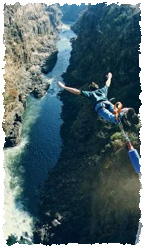Bungee Jumping
Insider Info
"It's the mix of excitement and fear. The speed of your blood running
through your veins. Your heart beating as fast as it can. The feeling of letting
go. Of putting yourself 100 percent in God's hands. Of giving it all.
Feeling so vulnerable. And as you're falling, asking yourself why you
did it."
 |
| This person is jumping off the Victoria Falls Bridge in southern
Africa. |
| Courtesy of: Laura A Rosensteel |
That's how Barbara Hang describes why she likes bungee jumping.
Bungee jumping is basically the art of throwing yourself off a very high
platform, with only a rubber cord strapped to your ankles to keep you from
hitting the ground.
Those who do it jump from various locations, like bridges or towers. It's
an extreme sport that is definitely not for the fainthearted. Those who jump
say there's absolutely nothing like it.
Bungee jumping is usually done outdoors. Many bungee jumping companies
set up their operations under high bridges, some over canyons and rivers,
and some over roads. Often, traveling fairs will have portable bungee jumping
towers.
Those who operate major bungee jumping facilities swear that this activity
is safe. And they all have track records to prove it.
"Contrary to popular belief, bungee jumping is statistically safer than
driving to work, riding a roller-coaster or showering at home," says Paul
Adamo. He's president of Adrenalin Dreams Adventures Inc.
Usually, the biggest fear jumpers have is that the rubber bungee cord will
snap. But operators say this is impossible if the equipment is well maintained
and not abused. The biggest safety factor lies in the experience of the crew.
Before you strap in, always check a company's safety record.
It's difficult to say how many people do bungee jumping, since no
one keeps records. But it's safe to say that there are more people trying
it all the time.
"I believe that the number of jumpers here in the U.S. may increase rapidly
from mere thousands per year today to tens of thousands within the next few
years," says Adamo.
The most obvious trend in bungee jumping these days is the bungee cord
itself. Design is always improving, making the cords both safer and smoother.
Smoothness is important because no one wants a severe jerk when they jump.
Getting Started
Location, location, location! Like real estate, the cost of bungee jumping
mostly depends on where the operation is located. The cost also depends on
the actual height of the jump and who the operator is.
Prices can range from around $35 (to get you into the fair grounds with
unlimited jumps on a small bungee) to $600 for a daring jump off a bridge.
Often, the expensive-sounding bridge jumps are split between a group of friends
(say five, six or seven people) with unlimited jumps.
Just about anyone can bungee jump. You don't need any special skills.
You don't even need to be in shape! All you need to do is somehow conquer
your fear of death.
Believe it or not, injuries are rare in bungee jumping. These days, the
bungee cords give you such a smooth ride that you don't have to worry
about a sore neck or back. The only real danger in bungee jumping is the cord
snapping. But this is extremely rare. Equipment failure is almost unheard
of. The key to safety is to jump with a reputable operator.
Bungee jumping is a recreation that can also be enjoyed by people with
physical challenges. Some operations are even set up to handle people in wheelchairs.
If ankle harnesses can't be used, some are simply put in a body harness
and off they go! Bungee jumping is also enjoyed by the hearing impaired and
the blind.
Some people turn their love of bungee jumping into careers. They set up
their own bungee jumping operations. Others take it further by combining bungee
jumping with other thrilling rides, like catapulting, rappelling or white
water adventures. Another way to earn money from bungee jumping is to become
part of a crew.
All it takes to get started bungee jumping is a lot of nerve. You may want
to go with a few friends so you can spur each other on. Once you've decided
to do it, look up an operator near you. When you find one, be sure to check
their track record and ask about the crew. How experienced are they? Always
follow instructions!
Publications
Bungee Jumping,
by
Jason Glaser Capstone
1999
Bungee Jumping and Other Science Questions,
by
Brenda Naylor, Ged Mitchell and Stuart Naylor
Published by
Hodder and Stoughton
2000
Links
U.S. and Canadian Bungee Clubs
Find a club near you
Steve Fettke Bungee Jumping
A site full of interesting facts and information
JoJaffa Goes Bungee Jumping
Another site full of bungee jumping info
Bungee Jumping in Cyprus
See how they do it Down Under
Back to Career Cluster